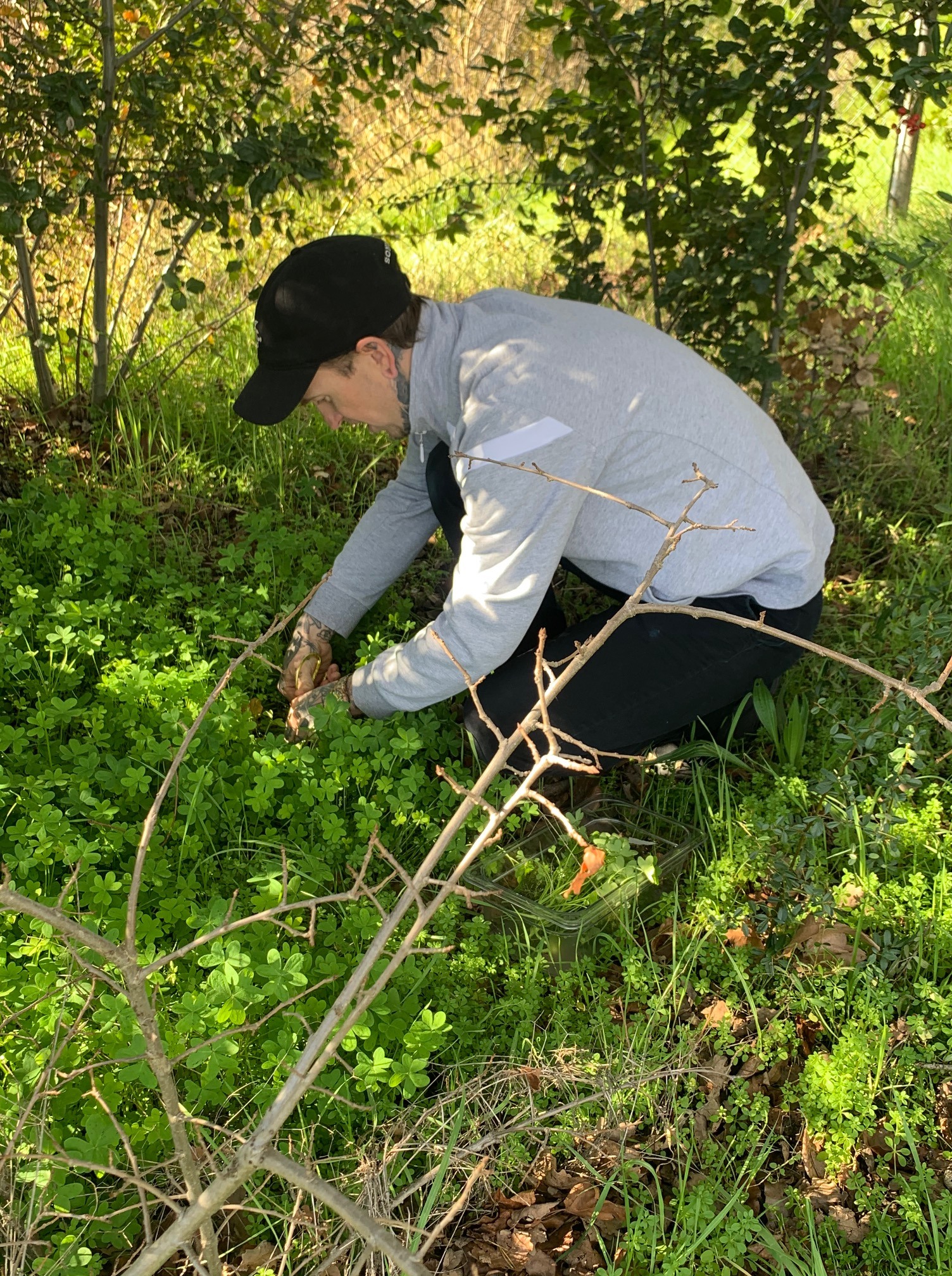Edible Excursions: Foraging in Your Own Backyard
Edible Excursions: Foraging in Your Own Backyard
Tips from Executive Chef Cole Dickinson of Layla
Whether you’re seeking to expand your culinary horizons, minimize your grocery expenses, enjoy an outdoor adventure or just maximize the extra time on your hands — an edible excursion might just be the ticket. Our very own Chef Cole is an avid forager, collecting fresh greens, herbs and garnishes for Layla from the beautiful and bountiful hillsides and creeksides of Napa and Sonoma. He shares 5 key foraging tips for beginners, as well as a list of 10 abundant wild foods to look for this Spring — and how to use them in the kitchen.
Foraging: Sage Advice for Beginners
Be mindful of where you forage, what you harvest and how you harvest:
- Stick to public parks and trails, or to your own backyard. Try to pick items that are at least 50 feet from the nearest road or trail to avoid contamination, and to preserve the scenery.
- Tread lightly and carefully, and watch for poison oak, ticks and other hazards.
- Pick only what you need. Foraged food should serve as an accent or garnish, rather than as the meal’s mainstay as there might not be an abundance of the wild item.
- Harvest with kitchen scissors or a pocket knife, making sure the root systems and colonies of plants remain intact so that you and others can come back for more.
- If you’re not 100% sure it’s edible, don’t eat it. Wild vegetation makes a beautiful bouquet so it won’t go to waste! Consult a field guide or a reputable website. One of my favorite resources for all-things foraging is Hunter Angler Gardener Cook, a blog and how-to foraging guide from renowned chef and decades-long forager, Hank Shaw.
Ten Edible Wild Foods for Spring
See below for Photo Gallery and Chef Cole’s descriptions of these 10 wild foods: Mustard Flowers – Calendula – Radish – Wood Sorrel – Fennel – Peruvian Peppercorns – Watercress – Lemon Balm – Arugula – Miner’s Lettuce
- Mustard Flowers. This brightly-colored yellow flower is ever-present amidst the vineyard rows in Sonoma wine country, so it’s an easy find. Every part of the mustard plant, part of the Brassicaceae family (broccoli, cabbage, kale, brussels sprouts and bok choy), is edible although we primarily use its flowers which have a spicy mustard taste. They’re a beautiful garnish that add complementary texture, color and spice to many chilled dishes.
- Calendula. Part of the daisy family, this “weedy” flower grows easily and extensively in backyards, fields, canyons and neighborhood streets. Although most known for its medicinal uses, the brilliant orange and yellow calendula petals are slightly peppery, offering a spicy “bite” to salads or a pop of color as an edible garnish for fresh foods and cocktails.
- Wild Radish Flowers. Growing abundantly along the California coast in early Spring, this Brassicaceae plant has four petals in a cross shape. Radish flowers range in color from white and cream to yellow and purple, and make a beautiful and peppery addition to any salad or cold presentation. We garnish the mango chutney for our cheese plate at Layla with purple radish flowers for a burst of color.
- Wood Sorrel. Also known as sourgrass, wood sorrel looks similar to clover and shamrocks in that it has three heart-shaped leaflets, usually green. All parts of this plant — leaves, flowers, seed pods, and roots — can be eaten, raw or cooked, and provide a great source of vitamin C. Its tart, lemon-like flavor is an ideal complement to veggie pastas, fish and in spring salads.
- Wild Fennel Fronds. Wild fennel grows in empty lots, meadows, roadsides — just about everywhere. During the spring, the green fronds sprout from the roots which then grow into tall cane-like stems. By mid-summer, the plant blooms with yellow “flowers” that are actually immature seeds that can be used to make “fennel pollen.” Unlike domesticated fennel, wild fennel does not have a large, edible bulb. Rather, its claims to fame are the springtime fronds and summertime seeds that have a distinctive sweet anise flavor. Use the fronds in salads, pastas or in homemade Italian sausage.
- Peruvian Pink Peppercorns. Also known as California pepper (although also prevalent in Florida and Hawaii), Peruvian pepper is an evergreen tree with a weeping canopy of branches, native to Northern Peru in the high desert of the Andes. It produces fresh, pink berries that can be dried and turned into peppercorns that can be ground, or used whole. They’re spicy and peppery, but have a very fragrant, sweet-tart and rosy tone – a flavor that works well in light sauces, fruity vinaigrettes or desserts.
- Watercress. This spicy green, which grows in or at the edge of creeks, ponds or streams, is a bit like horseradish or radishes in flavor. The warmer the season, the spicier the plants get, so for a milder spice, pick in the spring. Watercress is great in salads, as a garnish for poultry or fish, or even made into purees. Its spicy flavor is particularly good complement to sweet things – toss on top of a beet salad with orange segments and goat cheese.
- Lemon Balm. A perennial of the mint family, lemon balm has a fresh aroma and a floral, lemon-like flavor that is cooling, calming and mildly astringent. Known for its healthful benefits, lemon balm is often used for stomach aches, anxiety, hyperthyroid, colds and viruses. Gather the upper leaves, buds and flowers, strip them from the plant’s stem and infuse them in water for a hydrating herbal beverage. Dry the plant and make a refreshing herbal tea or use raw in a salad or as a flavorful garnish.
- Wild Arugula. Flowering right now in northern California is wild arugula.These plants grow everywhere and are easily identified, so get ready to enjoy an abundance of free salads! The more sun the plant gets, the more peppery the leaves, so harvest from shadier spots if you prefer a more delicate spice. The flowers are not only beautiful but also edible, so use the whole plant.
- Miner’s Lettuce. Ubiquitous at this time of year in cool, shady, moist spots, miner’s lettuce is the perfect salad green — it is crunchy, mild-tasting, remains tender, and is so loaded with vitamins C, A and iron it’ll ward off scurvy (the plant got its name because the Gold Rush miners ate it to stave off scurvy, caused by a vitamin C deficiency). Toss in a mixed green salad with a light mustard vinaigrette dressing for a tart, smooth and zippy-fresh taste.
Be safe, and have fun foraging for healthy, fresh and free food! We incorporate all of these wild ingredients into our seasonal dishes at Layla, which we look forward to sharing with you soon.
Happy foraging,
Chef Cole




